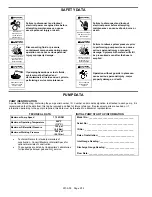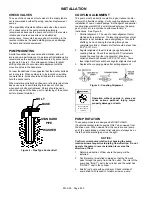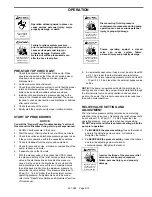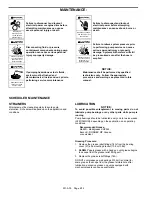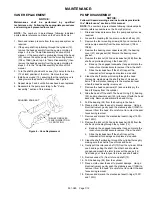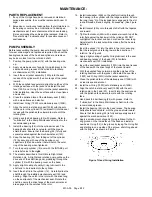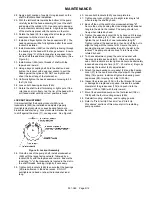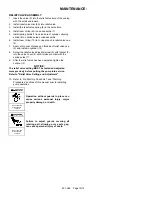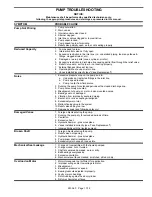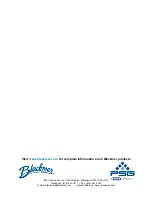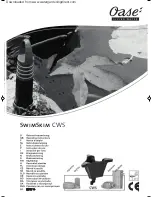
501-A00 Page 9/12
MAINTENANCE:
28. Apply a light coating of quality O-ring lubricant on the
shaft to facilitate head installation.
29. With the tell-tale hole towards the bottom of the pump,
carefully install the head assembly (20) over the shaft
and against the cylinder (12). Use care not to damage
the mechanical seal components. Align the drive tangs
of the mechanical seal with the notches in the rotor.
30. Rotate the head (20) to engage the drive tangs of the
seal jacket with the slots in the rotor.
31. Install and finger tighten the head capscrews (21). The
head capscrews will be fully tightened after the second
locknut is installed.
32. Install lockwasher (24B) on the shaft protruding through
the bearing in the head with the tangs outward. Ensure
the inner tang “A” of the lockwasher is engaged in the
slot in shaft threads. Bend it slightly, if necessary. (See
Figure 8.)
33. Install locknut (24A) onto threads of shaft with the
tapered end inward.
34. Using a keyed coupling half, hold the shaft end and
tighten the locknut with a spanner wrench to pull the
head against the cylinder. DO NOT overtighten and
shear the inner tang of the lockwasher.
35. Uniformly tighten the head capscrews, torquing to 25
lbs ft (34 Nm).
36. Loosen both bearing locknuts (24A).
37. Rotate the shaft to test for binding or tight spots. If the
rotor does not turn freely, tap the rim of the head with a
soft faced mallet until the correct position is found.
LOCKNUT ADJUSTMENT
It is important that the bearing locknuts (24A) and
lockwashers (24B) be installed and adjusted properly.
Overtightening locknuts can cause bearing failure or a
broken lockwasher tang. Loose locknuts will allow the rotor
to shift against the discs (71), causing wear. See Figure 8.
Figure 8– Locknut Assembly
38. On both ends of the pump shaft, install a lockwasher
(24B) with the tangs facing outward, followed by a
locknut (24A) with the tapered end inward. Ensure the
inner tang "A" of the lockwasher is located in the slot in
the shaft threads, bending it slightly, if necessary.
39. Tighten both locknuts (24B) to ensure that the bearings
(24) are bottomed in the head recess. DO NOT
overtighten and bend or shear the lockwasher inner
tang.
40. Loosen both locknuts (24A) one complete turn.
41. Tighten one locknut (24A) until a slight rotor drag is felt
when turning the shaft by hand.
42. Back off the nut the width of one lockwasher tang "B".
Secure the nut by bending the closest aligned lockwasher
tang into the slot in the locknut. The pump should turn
freely when rotated by hand.
43. Tighten the opposite locknut (24A) by hand until it is snug
against the bearing (24). Then, using a spanner wrench,
tighten the nut the width of one lockwasher tang “B”.
Tighten just past the desired tang, then back off the nut to
align the tang with the locknut slot. Secure the nut by
bending the aligned lockwasher tang into the slot in the
locknut. The pump should continue to turn freely when
rotated by hand.
44. To check adjustment, grasp the nut and washer with
fingers and rotate back and forth. If this cannot be done,
one or both locknuts are too tight and should be alternately
loosened one stop at a time (.001" - 25 microns). Begin by
loosening the locknut (24A) adjusted last.
45. Attach the new bearing cover gasket (26) and the bearing
cover (27) to the non-driven side of pump with the grease
fitting (76) upward. Install and tighten the bearing cover
capscrews (28), torquing to 15 lbs ft (20 Nm).
46. Inspect the grease seal (104) in the foot bracket for wear
or damage and replace as required. Grease the outside
diameter of the grease seal (104) and push it into the
bracket (108 or 108B) with the lip inward.
47. Mount the assembled pump on the foot bracket (108 or
108B) with the four mounting screws (28A).
48. Reinstall coupling, shaft key, and coupling guards.
49. Refer to “Pre-Start Up Check List” and “Start Up
Procedures” sections of this manual prior to restarting
pump operation.


